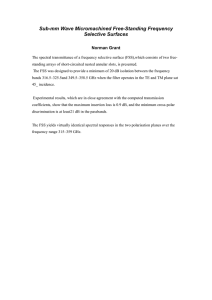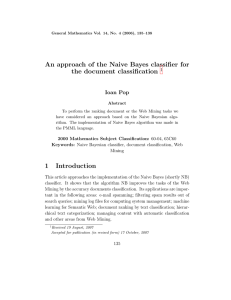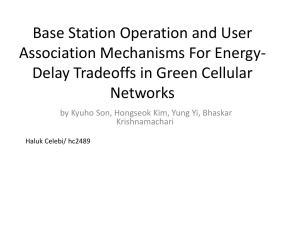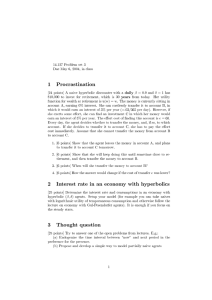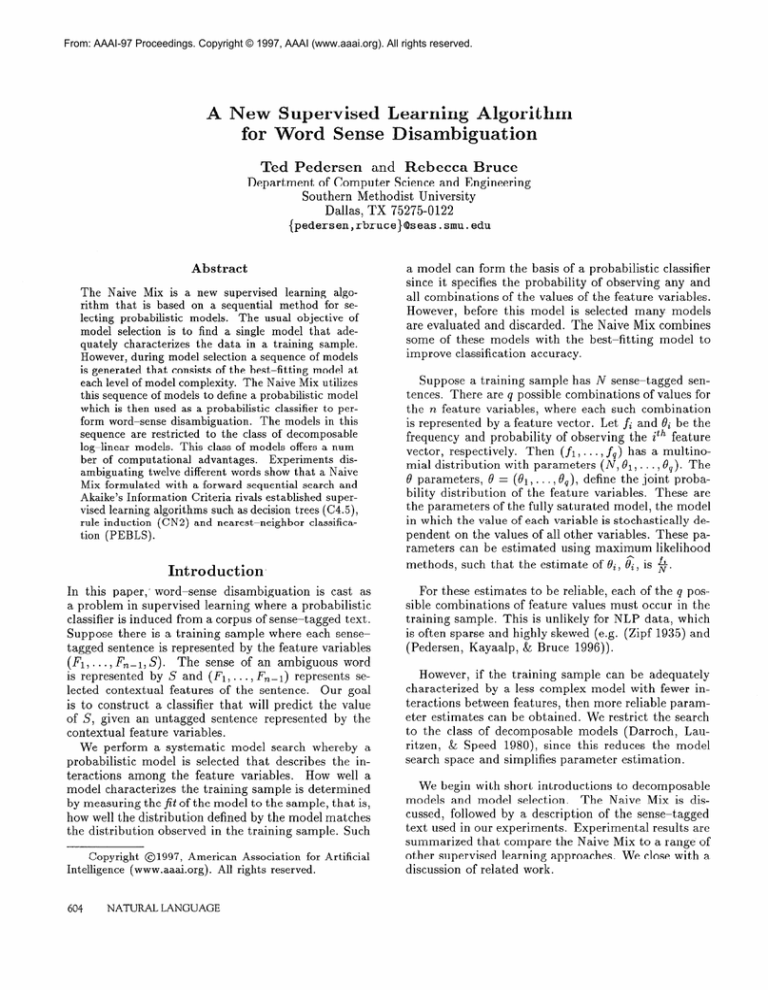
From: AAAI-97 Proceedings. Copyright © 1997, AAAI (www.aaai.org). All rights reserved.
A New Supervised
for Word
Sense
Ted Pedersen
and Rebecca
Bruce
Department
of Computer Science and Engineering
Southern Methodist University
Dallas, TX 75275-0122
{pedersen,rbruce}@seas.smu.edu
Abstract
The Naive Mix is a new supervised
learning algorithm that is based on a sequential
method for selecting probabilistic
models.
The usual objective
of
model selection is to find a single model that adequately characterizes
the data in a training sample.
However, during model selection a sequence of models
is generated that consists of the best-fitting
model at
each level of model complexity.
The Naive Mix utilizes
this sequence of models to define a probabilistic
model
which is then used as a probabilistic
classifier to perform word-sense
disambiguation.
The models in this
sequence are restricted
to the class of decomposable
log-linear
models. This class of models offers a number of computational
advantages.
Experiments
disambiguating
twelve different words show that a Naive
Mix formulated
with a forward sequential search and
Akaike’s Information
Criteria rivals established supervised learning algorithms such as decision trees (C4.5),
rule induction
(CN2) and nearest-neighbor
classification (PEBLS).
IntroductionIn this paper,’ word-sense
disambiguation
is cast as
a problem in supervised learning where a probabilistic
classifier is induced from a corpus of sense-tagged
text.
Suppose there is a training sample where each sensetagged sentence is represented by the feature variables
F,_l, S). The sense of an ambiguous word
(PI,...,
is represented by S and (Fl, . . . , F,- 1) represents selected contextual
features of the sentence.
Our goal
is to construct
a classifier that will predict the value
of S, given an untagged sentence represented
by the
contextual feature variables.
We perform a systematic
model search whereby a
probabilistic
model is selected that describes the interactions
among the feature variables.
How well a
model characterizes
the training sample is determined
by measuring the fit of the model to the sample, that is,
how well the distribution defined by the model matches
the distribution observed in the training sample. Such
Copyright 01997,
American
Association
for Artificial
Intelligence
(www.aaai.org).
All rights reserved.
604
NATURAL LANGUAGE
a model can form the basis of a probabilistic
classifier
since it specifies the probability
of observing any and
all combinations
of the values of the feature variables.
However, before this model is selected many models
are evaluated and discarded. The Naive Mix combines
some of these models with the best-fitting
model to
improve classification
accuracy.
Suppose a training sample has N sense-tagged
sentences. There are q possible combinations
of values for
the n feature variables, where each such combination
is represented by a feature vector. Let fi and 8i be the
frequency and probability of observing the ith feature
vector, respectively.
Then (fi, . . . , fq) has a multinomial distribution
with parameters
(N, 81,. . . ,19~). The
0 parameters,
19= (Qi, . . . , Q,), define the joint probability distribution
of the feature variables.
These are
the parameters of the fully saturated model, the model
in which the value of each variable is stochastically
dependent on the values of all other variables. These parameters can be estimated using maximum likelihood
methods,
such that the estimate
of Bi, 6,
is 5.
For these estimates to be reliable, each of the q possible combinations
of feature values must occur in the
training sample. This is unlikely for NLP data, which
is often sparse and highly skewed (e.g. (Zipf 1935) and
(Pedersen, Kayaalp, & Bruce 1996)).
However, if the training sample can be adequately
characterized
by a less complex model with fewer interactions between features, then more reliable parameter estimates can be obtained. We restrict the search
to the class of decomposable
models (Darroch,
Lauritzen, & Speed 1980), since this reduces the model
search space and simplifies parameter estimation.
We begin with short introductions
to decomposable
models and model selection.
The Naive Mix is discussed, followed by a description of the sense-tagged
text used in our experiments.
Experimental
results are
summarized that compare the Naive Mix to a range of
other supervised learning approaches.
We close with a
discussion of related work.
Decomposable
Model
Models
Decomposable
models are a subset of the class of
graphical models (Whittaker
1990) which is in turn
a subset of the class of log-linear
models (Bishop,
Fienberg,
& Holland 1975).
Although there are far
fewer decomposable
models than log-linear models for
a given set of feature variables, these classes have substantially the same expressive power (Whittaker
1990).
In a graphical model, variables are either interdependent or conditionally
independent of one another.’
All graphical models have a graphical representation
such that each variable in the model is mapped to a
node in the graph, and there is an undirected
edge
between each pair of nodes corresponding
to interdependent variables.
The sets of completely connected
nodes, i.e. cliques, correspond to sets of interdependent variables.
Any two nodes that are not directly
connected
by an edge are conditionally
independent
given the values of the nodes on the path that connects them.
Decomposable
models are those graphical
models
that express the joint distribution
as the product of
the marginal distributions
of the variables in the maximal cliques of the graphical representation,
scaled by
the marginal distributions
of variables common to two
or more of these maximal sets.
For example, the parameter
estimate $z,>:;:;s
is
the probability
that the feature vector (fi, fz, fa, s)
will be observed in a training
sample where each
observation
is represented
by the feature variables
(Fr , F2, Fs, S), and fi and s are specific values of
Suppose that the graphical representaFi and S.
tion of a decomposable
model is defined by the two
cliques, i.e. marginals,
(Fl,S)
and (F2, Fs, S).
The
frequencies
of these marginals,
f( Fl = fi, S = s)
and f(F2 = f2, Fa = fa, S = s), are sufficient statistics in that they provide enough information
to calculate maximum likelihood estimates
(MLEs)
of the
model parameters.
The MLEs of the model parameters are simply the marginal frequencies normalized
by the sample size N. The joint parameter estimates
are formulated from the model parameter estimates as
follows:
f(Fl=fl,S=s)
$M'2,F3,S
=
x
f(F2=f2,F3=f3,S=S)
N
(1)
fl,f2,f3jS
N
Thus,
it is only necessary to observe the marginals
the parameter.
(fl,s)
and (f2,.f3+)
t o estimate
Because their joint distributions
have such closedform expressions, the parameters can be estimated directly from the training sample without the need for an
iterative fitting procedure as is required, for example,
to estimate the parameters of maximum entropy models (e.g., (Berger, Della Pietra, & Della Pietra 1996)).
2~2 and F5 are
p(F2 = f21F5 = f5,S
conditionally
= s) = p(F2
independent
=
f2lS
=
3).
given
5’ if
Selection
Model selection integrates
a search strategy
and an
evaluation criterion.
The search strategy determines
which decomposable
models, from the set of all possible decomposable
models, will be evaluated during the
selection process.
In this paper backward sequential
search (BSS) and forward sequential search (FSS) are
used. Sequential searches evaluate models of increasing
(FSS) or decreasing (BSS) levels of complexity, where
complexity, c, is defined by the number of edges in the
graphical representation
of the model. The evaluation
criterion judges how well the model characterizes
the
data in the training sample.
We use Akaike’s Information Criteria (AIC) (Akaike 1974) as the evaluation
criterion based on the results of an extensive comparison of search strategies and selection criteria for model
selection reported in (Pedersen, Bruce, & Wiebe 1997).
Search
Strategy
BSS begins by designating the saturated model as the
current model. A saturated model has complexity level
c=?+3
, where n is the number of feature variables.
At each stage in BSS we generate the set of decomposable models of complexity level c - 1 that can be
created by removing an edge from the current model
of complexity
level c. Each member of this set is a
hypothesized model and is judged using the evaluation
criterion to determine which model results in the least
degradation in fit from the current model-that
model
becomes the current model and the search continues.
At each stage in the selection procedure, the current
model is the best-fitting
model found for complexity
level c. The search stops when either (1) every hypothesized model results in an unacceptably
high degradation in fit or (2) th e current model has a complexity
level of zero.
FSS begins by designating
the model for independence as the current model. The model for independence has complexity level of zero since there are no
interactions
among the feature variables. At each stage
in FSS we generate the set of decomposable
models of
complexity level c + 1 that can be created by adding
an edge to the current model of complexity
level c.
Each member of this set is a hypothesized
model and
is judged using the evaluation criterion to determine
which model results in the greatest improvement in fit
from the current model-that
model becomes the current model and the search continues. The search stops
when either (1) every hypothesized model results in an
unacceptably
small increase in fit or (2) the current
model is saturated.
For sparse samples FSS is a natural choice since early
in the search the models are of low complexity.
The
number of model parameters is small and they can be
more reliably estimated from the training data. On the
other hand, BSS begins with a saturated model whose
parameter estimates are known to be unreliable.
LANGUAGE & LEARNING
605
During both BSS and FSS, model selection also performs feature selection.
If a model is selected where
there is no edge connecting
a feature variable to the
classification
variable then that feature is not relevant
to the classification
being performed and is removed
from the model.
Evaluation
Criteria
Akaike’s Information
Criteria (AIC) is an alternative
to using a pre-defined significance
level to judge the
acceptability
of a model. AIC rewards good model fit
and penalizes models with large numbers of parameters
via the following definition:
AIC = G2 - 2 x dof
(2)
Model fit is measured by the Log-likelihood
ratio
penalty is expressed as
statistic
G2. The parameter
2 x dof where dof is the adjusted degrees of freedom of
the model being evaluated.
The adjusted dof is equal
to the number of model parameters
that can be estimated from the training sample.
The Log-likelihood
ratio statistic is defined as:
(3)
where fi and ei are the observed and expected counts
for the ith feature ve ctor, respectively.
The observed
count fi is simply the frequency in the training sample.
The expected count ei is the count in the distribution
defined by the model. The smaller the value of G2 the
better the fit of the hypothesized model.
During BSS the hypothesized model with the largest
negative AIC value is selected as the current model, i.e.
the best-fitting
model, of complexity level c - 1, while
during FSS the hypothesized
model with the largest
positive AIC value is seleMed as the current model of
complexity level c+ 1. The fit of all hypothesized models is judged to be unacceptable
when the AIC values
for those models are greater than zero in the case of
BSS, or less than zero in the case of FSS.
The Naive Mix
The Naive Mix is based on the premise that the bestfitting model found at each level of complexity during
a sequential search has important information that can
be exploited for word-sense disambiguation.
A Naive
Mix is a probabilistic
classifier based on the average of
the distributions
defined by the best-fitting
models at
each complexity level.
Sequential model selection results in a sequence of
decomposable
models (ml, m2, . . . , m,__ 1, m,)
where
ml is the initial model and m, is the final model selected. Each model rni was designated as the current
model at the ith stage in model selection. During FSS
ml is the model for independence
where all feature
variables are independent
and there are no edges in
the graphical representation
of the model. During BSS
606
NATURAL LANGUAGE
ml is the saturated model where all variables are completely dependent and edges connect every node in the
graphical representation
of the model.
A Naive Mix is formulated
as the average of the
joint probability distributions
defined by each model in
the sequence (ml, m2, . . . , m,_ 1, m,) generated during
model selection:
i=l
,s>m,represents
the joint parameter
estimates formulated from the parameters
of the decomposable model rni .
The averaged joint distribution is defined by the average joint parameters and used as the basis of a probabilistic classifier. Suppose we wish to classify a feature
vector having values (fl , f2, . . . , fn- 1,S) where the unknown sense is represented by the variable S. The feature vector (fi, . . . , fn__l)represents the values of the
observed contextual features.
S takes the sense value
that has the highest probability of occurring with the
observed contextual features, as defined by the parameter estimates:
where
gF1
,...,Fn-l
s=
argmax rF1,Fz,...,Fn--1,S)auerage
s
%,f2
,...,
fn--1,s
(5)
We prefer the use of FSS over BSS for formulating a Naive Mix.
FSS incrementally
builds on the
strongest interactions
while BSS incrementally
elimiAs a result, the innates the weakest interactions.
termediate models generated during BSS may contain
irrelevant interactions.
Experimental
Data
The sense-tagged
text used in these experiments
is
Wiebe, & Pedersen 1996)
that described in (Bruce,
and consists of every sentence from the ACL/DCI Wall
Street Journal corpus that contains any of the nouns
interest, bill, concern, and drug, any of the verbs close,
help, agree, and include, or any of the adjectives chief,
public, last, and common.
The extracted sentences were manually tagged with
senses defined in the Longman
Dictionary
of Contemporary English (LDOCE).
The number of possible
senses for each word as well as the number of sensetagged training sentences and held-out test sentences
for each word are shown in Figure 2.
A sentence with an ambiguous word is represented
by a feature set with three types of contextual feature
variables, one morphological feature describing the ambiguous word, four part-of-speech
(POS) features describing the surrounding words, and three collocation
based features.
The morphological
feature is binary for nouns, indicating if the noun is plural or not.
For verbs it
indicates the tense of the verb.
This feature is not
used for adjectives.
Each of the four POS feature variables can have one of 25 possible POS tags.
These
/y
L
agree
bill
chief
close
common
concern
drug
help
include
interest
last
public
Figure
fi
I c3-
c/l
c’2
million
auction
economist
at
million
about
company
him
are
in
month
going
that
discount
executive
cents
sense
million
FDA
not
be
percent
week
offering
1: Collocation-specific
to
treasury
officer
trading
share
that
generic
then
in
rate
year
school
variables
tags are derived from the first letter of the tags in the
ACL/DCI
WSJ corpus.
There are four POS feature
variables representing the POS of the two words immediately preceding and following the ambiguous word.
The three binary collocation-specific
feature variables
indicate whether or not a particular word occurs in the
same sentence as the ambiguous word. These collocations are shown in Figure 1. They were selected from
among the 400 words that occurred most frequently
in the sentences containing the ambiguous word. The
three words chosen were found to be the most indicative of the sense of the ambiguous word using a test
for independence.
Experimental
Results
The success of a learning algorithm when applied to
a particular problem depends on how appropriate the
assumptions made in formulating the algorithm are for
the data in that problem. The assumptions implicit in
the formulation of a learning algorithm result in a bias,
a preference for one generalized representation
of the
training sample over another.
In these experiments we use the following nine different methods to disambiguate each of the 12 ambiguous
words. Below, we briefly describe each algorithm.
Majority
classifier: The performance
of a probabilistic classifier should not be worse than the majority classifier which assigns to each ambiguous word the
most frequently occurring sense in the training sample.
Naive Bayes classifier (Duda & Hart 1973):
A
probabilistic
classifier based on a model where the features (Fr, F2,. . . , Fn-l) are all conditionally
independent given the value of the classification
variable S.
n-l
P(SjFl,F2,...,F,-l)
=
P(Fi IS)
(6)
This classifier is most accurate when the model for conditional independence
fits the data.
PEBLS
(Cost & Salzberg
1993):
A I% nearestneighbor algorithm where classification
is performed
by assigning a test instance to the majority
class of
the k closest training examples.
In these experiments
we used k = 1, i.e. each test instance is assigned the
tag of the single most similar training instance, and all
features were weighted equally. With these parameter
settings, PEBLS is a standard nearest-neighbor
classifier and is most appropriate for data where all features
are relevant and equally important for classification.
C4.5 (Quinlan 1992): A decision tree algorithm in
which classification rules are formulated by recursively
partitioning
the training sample.
Each nested partition is based on the feature value that provides the
greatest increase in the information
gain ratio for the
current partition.
The final partitions correspond to a
set of classification
rules where the antecedent of each
rule is a conjunction
of the feature values used to form
the corresponding
partition.
The method is biased toward production of simple trees, trees with the fewest
partitions, where classification is based on the smallest
number of feature values.
CN2 (Clark & Niblett 1989): A rule induction algorithm that selects rules that cover the largest possible subsets of the training sample as measured by the
Laplace error estimate.
This method is biased towards
the selection of simple rules that cover as many training instances as possible.
FSS/SSS
AIC: A probabilistic
classifier based on
the single best-fitting
model selected using FSS or BSS
with AIC as the evaluation criterion. Both procedures
are biased towards the selection of models with the
smallest number of interactions.
FSS/SSS
AIC N aive Mix: A probabilistic
classifier based on the averaged joint probability distribution
of the sequence of models,
(ml, m2, . . . , m,_ 1, m,),
generated
during FSS AIC or BSS AIC sequential
search. Each model, mi, generated during FSS AIC is
formulated by potentially extending the feature set of
the previous model mi- 1. Each model, mi, generated
during BSS AIC is formulated by potentially
decreasing the feature set of the previous model mi_1. Both
methods are biased towards the classification
preferences of the most informative features, those included
in the largest number of models in the sequence.
Figure 2 reports the accuracy of each method applied to the disambiguation
of each of the 12 words.
The highest accuracy achieved for each word is in bold
face. At the bottom of the table, the average accuracy
of each method is stated along with a summary comparison of the performance of each method to FSS AIC
Naive Mix. The row designated win-tie-loss
states the
number of words for which the accuracy of FSS AIC
Naive Mix was greater than (win), equal to (tie), or
less than (loss) the method in that column.
C4.5, FSS AIC Naive Mix, and Naive Bayes have
the highest average accuracy.
However, the difference
between the most accurate, C4.5, and the least accurate, PEBLS,
is only 2.4 percent.
In a word-by-word
comparison,
C4.5 most often achieves the highest ac-
LANGUAGE
& LEARNING
607
I
word/
# senses
agree/3
bill/3
chief/2
close/6
common/6
concern/4
drug/2
help/4
include/2
interest/6
last/3
public/7
average
win-tie-loss
# train/
# test
1356/141
1335/134
1036/112
1534/157
1111/115
1488/149
1217/122
1398/139
15581163
2368/244
3180/326
867/89
Majority
classifier
.766
.709
.875
.682
.870
.651
.672
.727
.933
.521
.939
.506
.738
11-1-o
Naive
Bayes
.936
.866
.964
.834
.913
.872
.828
.748
.951
.738
.926
.584
.847
6-l-5
PEBLS
.922
.851
.964
.860
.904
.a19
.770
.777
.951
.717
.948
.539
.835
8-2-2
c4.5
.959
.881
.982
.828
.922
.839
.812
.791
a969
.783
.957
.584
,859
3-3-6
Figure 2: Disambiguation
curacy of all methods. FSS AIC fares most poorly in
that it is never the most accurate of all the methods.
The win-tie-loss
summary shows that FSS AIC
Naive Mix compares most favorably to PEBLS and
FSS AIC, and fares least well against C4.5 and BSS
AIC Naive Mix. The high number of losses relative to
BSS AIC Naive Mix is an interesting contrast to the
lower average accuracy and word-by-word performance
of that method. But it highlights the competitive performance of BSS AIC Naive Mix on this data set.
FSS AIC Naive Mix, FSS AIC, C4.5 and CN2 all
perform a general-to-specific
search that adds features
to their representation of the training sample based on
some measure of information content increase. These
methods all perform feature selection and have a bias
towards simpler models. The same is true of BSS AIC
and BSS AIC Naive Mix which perform a specific-togeneral search for the simplest model.
All of these
methods can suffer from fragmentation
with sparse
data. Fragmentation occurs when the rules or model
are complex, incorporating
a large number of feature
values to describe a small number of training instances.
When this occurs, there is inadequate support in the
training data for the inference being specified by the
model or rule. FSS AIC Naive Mix was designed to
reduce the effects of fragmentation
in a general-tospecific search by averaging the distributions of high
complexity models with those of low complexity models that include only the most relevant features.
Nearest-neighbor
approaches such as PEBLS are
well-suited to making classifications
that require the
use of the full feature set as long as all features are
independent
and relevant.
Neither the Naive Bayes
classifier nor PEBLS perform a search to create a representation of the training sample. The Naive Bayes
specifies the form of a model in which all features are
608
NATURAL
LANGUAGE
CN2
.943
.881
.964
.822
.896
.859
.795
.813
.969
.713
.939
.517
.843
7-l-4
FSS
AIC
.936
.858
.964
.841
.896
.826
.812
.791
.945
.734
.929
.528
.838
9-2-l
FSS AIC
Naive
Mix
.957
.888
.973
.803
.904
.846
.828
.791
.969
.734
.939
.539
.848
BSS
AIC
.922
.851
,964
.841
.896
.839
.844
.791
.939
.742
.942
.517
.841
7-l-4
BSS AIC
Naive
Mix
,922
.828
.955
.854
.922
.852
.787
.806
.933
.738
.948
.562
.842
5-o-7
Accuracy
used in classification but, as in PEBLS, their interdependencies are not considered.
Weights are assigned
to features via parameter estimates from the training
sample. These weights allow some discounting of less
relevant features. As implemented here, PEBLS stores
all instances of the training sample and treats each
feature independently and equally, making it more susceptible to misclassification
due to irrelevant features.
As shown in (Bruce, Wiebe, & Pedersen 1996), all of
the features used in these experiments are good indicators of the classification variable, although not equally
so. The lower accuracy of PEBLS relative to Naive
Bayes indicates that some weighting is appropriate.
Sequential model selection using decomposable
models was first applied to word-sense
disambiguation
in (Bruce & Wiebe 1994).
The Naive Mix extends
that work by considering an entire sequence of models
rather than just the best-fitting
model.
Comparative studies of machine learning algorithms
applied to word-sense
disambiguation
are relatively
rare. (Leacock, Towell, & Voorhees 1993) compares a
neural network, a Naive Bayes classifier, and a content vector when disambiguating
six senses of line.
They report that all three methods are equally accurate. (Mooney 1996) utilizes this same data and applies an even wider range of approaches comparing a
Naive Bayes classifier, a perceptron,
a decision-tree,
a nearest-neighbor
classifier, a logic based Disjunctive
Normal Form learner, a logic based Conjunctive
Normal Form learner, and a decision list learner. He finds
the Naive Bayes classifier and the perceptron to be the
most accurate of these approaches.
The feature set in both studies of the line data was
very different than ours. Binary features represent the
occurrence of all words within approximately
a 50 word
window of the ambiguous
word, resulting in nearly
3,000 binary features. It is perhaps not surprising that
a simple model, such as Naive Bayes, would provide a
manageable representation
of such a large feature set.
PEBLS was first applied to word-sense disambiguation in (Ng & Lee 1996). Using the same sense-tagged
text for interest as used in this paper, they draw comparisons between PEBLS
and a probabilistic
classifier
based on the best-fitting
single model found during a
model search (Bruce & Wiebe 1994). They find that
the combination
of PEBLS
and a broader set of features leads to significant improvements
in accuracy.
In recognition of the uncertainty
in model selection,
there has been a recent trend in model selection research away from the selection of a single model (e.g.,
(Madigan & Raftery 1994)); the Naive Mix reflects this
trend. A similar trend exists in machine learning based
on the supposition that no learning algorithm is superior for all tasks.
This supposition
has lead to hybrid approaches that combine various methods (e.g.,
(Domingos 1996)) and approaches that select the most
appropriate learning algorithm based on the characteristics of the training data (e.g., (Brodley 1995)).
Conclusion
The Naive Mix extends existing statistical
model selection by taking advantage
of intermediate
models
discovered during the selection process.
Features are
selected during a systematic
model search and then
appropriately
weighted via averaged parameter
estimates. Experimental
evidence suggests that the Naive
Mix results in a probabilistic
model that is usually
a more accurate classifier than one based on a single model selected during a sequential search. It also
proves to be competitive
with a diverse set of supervised learning algorithms such as decision trees, rule
induction, and nearest-neighbor
classification.
Acknowledgments
This research was supported
Research under grant number
by the Office of Naval
NO00 14-95- l-0776.
References
Akaike, H. 1974. A new look at the statistical model
identification.
IEEE Transactions on Automatic Control AC-19(6):716-723.
Berger,
A.;
Della Pietra,
S.;
and Della Pietra,
V.
1996.
A maximum entropy approach to natural language processing.
Computational
Linguistics
22( 1):39-71.
Bishop, Y.; Fienberg, S.; and Holland, P. 1975.
crete Multivariate
Analysis.
Cambridge,
MA:
MIT Press.
DisThe
Brodley, C. 1995. Recursive automatic bias selection
for classifier construction.
Machine Learning 20:6394.
Bruce, R., and Wiebe, J. 1994. Word-sense disambiguation using decomposable
models. In Proceedings
of the 32nd Annual Meeting of the Association for
Computational
Linguistics,
1399146.
Bruce, R.; Wiebe, J.; and Pedersen, T. 1996. The
measure of a model. In Proceedings of the Conference
on Empirical Methods in Natural Language Processing, 101-112.
Clark, P., and Niblett, T. 1989. The CN2 induction
algorithm.
Machine Learning 3(4):261-283.
Cost, S., and Salzberg,
S. 1993. A weighted nearest neighbor algorithm for learning with symbolic features. Machine Learning lO( 1):57-78.
Darroch,
J .; Lauritzen,
S.; and Speed, T.
1980.
Markov fields and log-linear interaction
models for
contingency tables. The Annals of Statistics 8(3):522539.
Domingos,
rule-based
P.
1996.
induction.
Unifying instance-based
and
Machine Learning 24:141-168.
Duda, R., and Hart, P. 1973. Pattern Classification
and Scene Analysis. New York, NY: Wiley.
Leacock,
C.; Towell, G.; and Voorhees,
E.
1993.
Corpus-based
statistical sense resolution. In Proceedings of the ARPA
Workshop on Human Language
Technology, 260-265.
Madigan,
D., and Raftery, A. 1994.
Model selection and accounting for model uncertainty
in graphical models using Occam’s Window. Journal of American Statistical Association 89:1535-1546.
Mooney, R. 1996. Comparative
experiments
on disambiguating word senses: An illustration of the role of
bias in machine learning. In Proceedings of the Conference
on Empirical
Methods in Natural Language
Processing, 82-9 1.
1996.
Integrating
multiple
Ng, H., and Lee, H.
knowledge sources to disambiguate
word sense: An
exemplar-based
approach. In Proceedings of the 34th
Annual Meeting of the Society for Computational
Linguistics, 40-47.
Pedersen, T.; Bruce, R.; and Wiebe, J. 1997. Sequential model selection for word sense disambiguation.
In
Proceedings of the Fifth Conference
on Applied Natural Language Processing.
Pedersen, T.; Kayaalp, M.; and Bruce, R. 1996. Significant lexical relationships.
In Proceedings
of the
Thirteenth National Conference
on Artificial Intelligence, 455-460.
Quinlan, J. 1992. C4.5: Programs for Machine
ing. San Mateo, CA: Morgan Kaufmann.
Learn-
Whittaker,
J. 1990. Graphical Models in Applied Multivariate Statistics. New York: John Wiley.
Zipf, G.
1935.
The Psycho-Biology
Boston, MA: Houghton Mifflin.
of Language.
LANGUAGE & LEARNING
609

